By Harry Looney – July 2025
The Virginia Department of Health (VDH) announced significant changes to its Harmful Algal Bloom (HAB) Recreational Advisory Protocol, effective for the current HAB season starting in April 2025. The most notable update is the removal of cyanobacteria cell counts as a primary trigger for issuing public health advisories. Moving forward, advisories will be based solely on the confirmed presence and concentration of cyanotoxins in water samples.
The VDH states that this revision, developed in collaboration with the Virginia Department of Environmental Quality (DEQ), aims to allow for more extensive and targeted monitoring of algal toxins and to align Virginia's approach with updated recommendations from the U.S. Environmental Protection Agency (EPA).
What's Changing and Why?
Previously, VDH utilized a "hybrid approach”, issuing advisories if either elevated cell counts of potentially toxigenic cyanobacteria or elevated toxin concentrations exceeded established thresholds. This conservative approach was adopted due to limited historical data on the relationship between cell densities and toxin levels.
However, after five years of data collection and analysis (2020-2024), VDH and DEQ determined that high cell counts do not always correlate with elevated toxin levels that pose a direct human health risk. Cell counts at Lake Anna have been exceeded each year since 2018 but none of the samples that were collected during this timeframe contained toxins above advisory levels. Based on these data of low toxin levels at Lake Anna and other lakes and waterbodies across the state, even when the cell counts greatly exceeded the established level of concern threshold, the VDH and DEQ decided to manage recreational advisories based on the actual presence of toxins, which are the direct cause of health concerns.
The new protocol emphasizes:
- Toxin-First Approach: Advisories will now be triggered when one or more of the four monitored cyanotoxins (microcystins, cylindrospermopsin, anatoxin-a, saxitoxin) exceed VDH's established health thresholds.
- Increased Certainty: VDH believes this change will increase the certainty that an advisory signifies a substantial health risk from HAB toxins, rather than just the presence of a high concentration of algae cells that may or may not be producing toxins.
- Alignment with EPA: This shift is consistent with EPA's recommendations, which prioritize toxin concentrations for recreational water quality criteria.
Community Concerns and Ongoing Advocacy
While the VDH highlights the scientific basis for this change, organizations like the Lake Anna Civic Association (LACA) and the Smith Mountain Lake Association (SMLA) have expressed significant concerns. They argue that removing cell counts as a primary trigger could:
- Reduce Proactive Warnings: Potentially delay public notification, as advisories would only be issued after toxins reach harmful levels, rather than during the early stages of bloom development when cell densities are already substantial.
- Increase Exposure Risk: Expose recreational users, especially vulnerable populations like children and pets, to potentially harmful conditions before toxins are confirmed.
- Undermine Funding for Mitigation: Diminish the perceived severity of HAB problems, potentially weakening the case for continued investment in mitigation strategies aimed at reducing the underlying causes of high cell densities, such as nutrient loading.
- Lose Early Warning Capability: Cell counts are often a cost-effective and rapid indicator of potential HAB development, preceding significant increases in detectable toxin concentrations. Sole reliance on reactive toxin testing may not adequately capture the temporal dynamics of bloom development.
What This Means for Lake Users and How to Stay Informed
Despite the protocol change, VDH and DEQ emphasize that they will continue to use all available information to analyze and alert the public to bloom risks.
It remains crucial for lake users to exercise caution. VDH advises avoiding contact with any discolored water, water that has an odor, or where dead or dying animals are observed. If contact occurs, rinse the affected area with clean water.
To stay informed about HAB events and advisories in Virginia:
- Bookmark www.SwimHealthyVa.com: This VDH website is the primary source for current HAB updates and recreational advisories.
- Utilize the HAB Online Report Form: If you suspect an algal bloom or scum, report it to VDH within 24-48 hours using their online form. Geographic coordinates and a picture of the bloom are essential for accurate reporting.
- Report Health Complaints: For suspected HAB-related health complaints, call the HAB Hotline at 1-888-238-6154.
The VDH and DEQ will continue to monitor Virginia's waterways, and public cooperation in reporting suspected blooms remains a vital component of protecting recreational health.
harry.looney@lakeannavirginia.org
